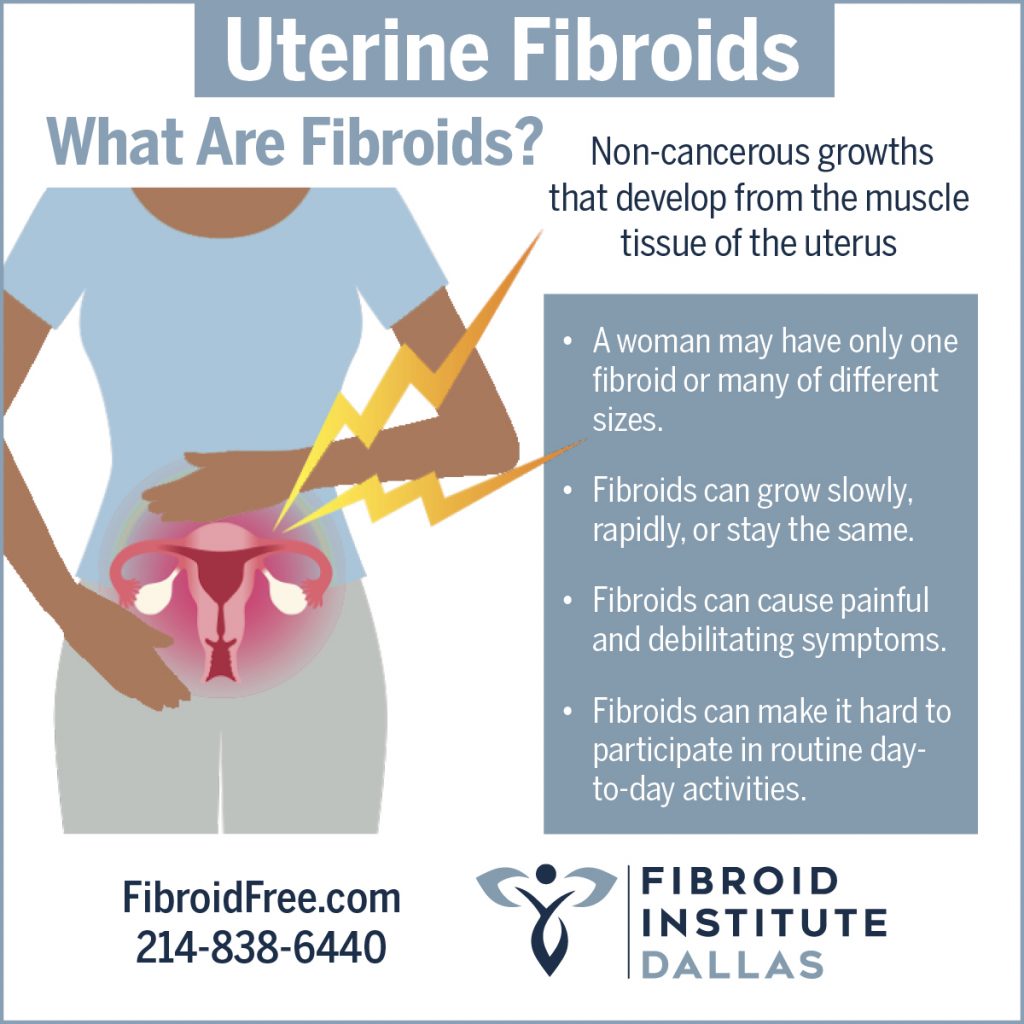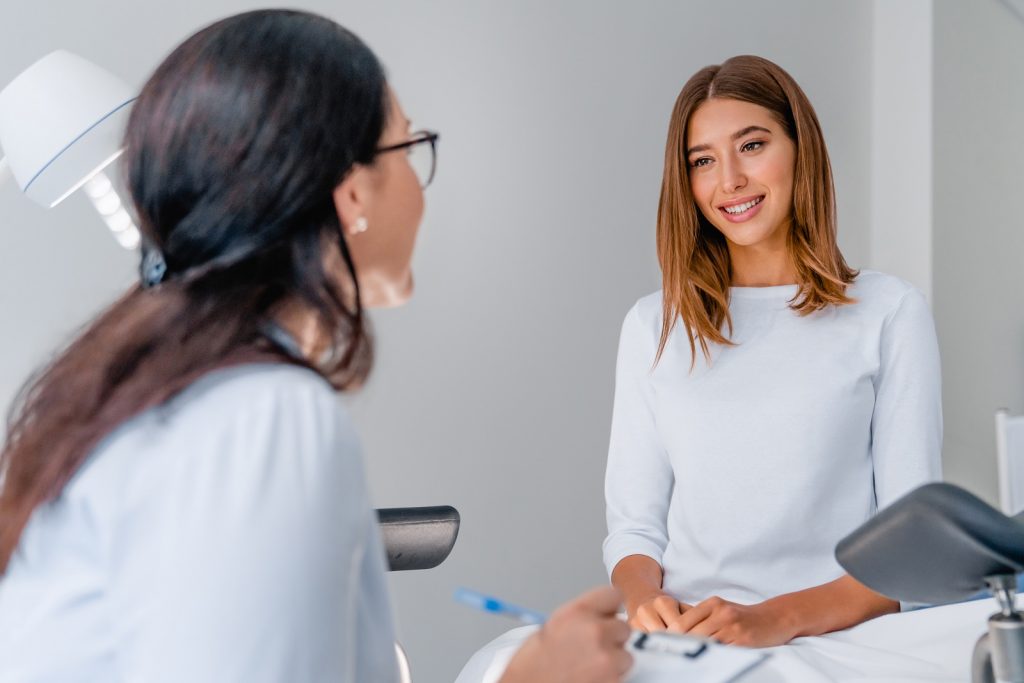Researchers estimate that as many as 3 out of 4 women will develop uterine fibroids during their lifetimes. And according to the U.S. Office on Women’s Health, about 20 to 80% of women will by the time they reach age 50. Clearly, those don’t sound like great odds. So perhaps you’re wondering if uterine fibroid pain can be prevented. Is there anything that you can do now to ensure that you don’t follow down the same path?
Preventing uterine fibroids and the discomfort associated with them may not be possible. Fibroids are very difficult to avoid because of a variety of factors that many of us can’t control. And the statistics above are proof of that. But by making healthy lifestyle choices, becoming educated on symptoms and warning signs of fibroid pain, and seeing your doctor regularly, you could decrease your risk, delay development, and find yourself in a position where your specific fibroid situation may not require treatment.
What Are Uterine Fibroids?

Uterine fibroids are benign tumors that develop from the muscle tissue of the uterus. They can develop in different locations, differ in size, and either stay that way or grow at different rates. Most women are unaware they have fibroids and will only accidentally discover them during a routine pelvic or pregnancy exam with their doctor. In other situations, patients may experience fibroid pain and other life-altering symptoms, especially as they grow and put more pressure on the uterus and bladder. This includes everything from long, painful periods and heavy menstrual bleeding to:
- Debilitating cramps, pelvic pain, and pressure
- Back or leg pain
- Bowel or bladder dysfunction
- Pain during sex
- Bloating or swelling in the lower abdomen
- Anemia, which can lead to fatigue
Not every woman experiences the same uterine fibroid pain or symptoms. The good news is that while most women will develop uterine fibroids in their lifetime, only 20% are symptomatic.
While we can’t point to a specific cause for uterine fibroids, these are a few common external factors:
1. Hormones
Fibroids are under hormonal control, particularly estrogen and progesterone. Both hormones stimulate the development of the uterine lining during each menstrual cycle in preparation for pregnancy. As a result, uterine fibroids tend to swell and grow faster during childbearing years when hormone levels are at their highest. Uterine fibroids tend to shrink during menopause, a period during which hormone levels are much lower.
2. Genetics
If your mother, grandmother, or sister has or had fibroids, your heredity predisposes you. In fact, the national Office on Women’s Health says your risk of also experiencing them is roughly three times higher.

3. Ethnicity
African American women are three times more likely to develop fibroids than any other ethnic group. In fact, 80% of Black women will develop fibroids by the time they are 50. The rate of hospitalization for fibroids is three times higher for Black women than white women. They are also two to three times more likely to undergo a hysterectomy and seven times more likely to have a myomectomy.
4. Age
Fibroids can form at any age, but they are more common between the ages of 40 and 50 since they grow throughout a woman’s lifetime as they are menstruating. As hormone levels decrease over the age of 50 and after menopause, uterine fibroids often stop growing or even shrink.
How Can Fibroid Pain and Symptoms Be Prevented?
Sadly, uterine fibroids can’t be prevented. Many, if not all, of the factors above, are out of your immediate control. As a result, your risk for developing fibroids is automatically high. The first thing to realize, however, is that being diagnosed with fibroids can be manageable. As we said earlier, only 20% of fibroid cases are symptomatic.
This means that most women who have uterine fibroids continue leading a normal life and simply monitor their health with routine visits to the doctor or gynecologist. Furthermore, technology has advanced so there are a variety of surgical and non-surgical treatment options should you have symptoms and fibroid pain.
Beyond that, research shows that healthy lifestyle habits may decrease your risk and manage symptoms. A common tip is to lower stress levels. Others include:
1. Choose your eating habits carefully — Eat more fruits, especially citrus, and vegetables. Eating a lot of red meat (e.g., beef) and sugary foods are linked to a higher risk of uterine fibroids. This also leads to weight gain, and according to the U.S. Office on Women’s Health, the risk for heavy women is two to three times greater than average. A healthy BMI, or Body Mass Index, is between 18.5 and 25.
2. Get more exercise — While you want to avoid engaging in intense or vigorous exercises such as bending and heavy lifting, lighter routines such as yoga, swimming, biking, walking, light weight training, and stretching can boost endorphins, relieve stress, improve your mood, and act as natural painkillers.

3. Avoid alcohol — Alcohol triggers inflammation and raises hormone levels. This increases your chances of developing fibroids and helps existing ones to grow.
4. Discuss birth control options with your doctor — Most women don’t know this, but some birth control methods can feed existing fibroids and help them grow. There are studies that show birth control pills can help with certain side effects of existing fibroids, but it’s worth noting that being on a regular birth control routine may put you at risk for uterine fibroids. Talk to your gynecologist to make sure the type of birth control you use is the best option for your situation.
5. Start a Vitamin D supplement routine — Studies show women with Vitamin D deficiencies not only experience poor muscle, bone, and immune system health, but they are also at an increased risk of developing uterine fibroids. You can add vitamin D to your diet by eating foods such as fatty salmon and tuna, cod liver oil and dairy products like fortified milk. Vitamin D is also generated by sunlight. In the short term, there is compelling research that suggests taking Vitamin D supplements may help stop fibroids from getting bigger and could keep fibroids at their current size.
How Can You Shrink Uterine Fibroids?
Following all the above suggestions might not yield the results you’re looking for. But again, the good news is that you do not have to continue to suffer with fibroid pain. Regular check-ups with your doctor can help keep up with your overall health and provide treatment options for uterine fibroid growth should it happen and become symptomatic.

In the past, surgical procedures such as a hysterectomy or myomectomy were the go-to options for women with painful uterine fibroids. And in many cases, they still are the first suggested option. But a study published in the American Journal of Obstetrics & Gynecology states that as many as 1 in 5 women in the United States whose doctor recommended a hysterectomy did not need one and that 37.7% of women included in the study did not undergo alternative treatment prior to surgery.
Consider Non-Surgical UFE
Uterine Fibroid Embolization (UFE) is a unique, low-risk, minimally invasive procedure for fibroid treatment. UFE uses X-ray guidance to locate the vessels that supply blood to your fibroids, then non-invasively block the blood flow to fibroids with small particles. This causes the fibroids to shrink and die rather than having to be surgically removed through bloody procedures. UFE offers over a 90% reduction in symptoms for women. UFE also treats all the fibroids at once, regardless of size and location. Additional advantages of UFE include:
- No hospital stay
- Uterus remains preserved
- Less risk than fibroid surgery
- Tiny wrist puncture, no need for vaginal access
- Short period of recovery (7 to 10 days in many cases)
- Same-day procedure
You Have Options for Your Fibroid Pain at Fibroid Institute Dallas
If you’re concerned about developing uterine fibroids in your lifetime, as well as potential treatment options, it is important to have an open conversation with your doctor. Many times, women find that they don’t need to have surgery at all and that more non-surgical options are present. Uterine Fibroid Embolization (UFE) is the gold standard in non-surgical fibroid treatment. Highly rated with 5-star reviews, Dr. Suzanne Slonim has become the preferred UFE provider for many referring physicians including gynecologists, internists, hematologists, wellness doctors, chiropractors, and general practitioners. With over 30,000 procedures completed in 25+ years of practice, she is voted as a top doctor by D Magazine, listed in Super Doctors by Texas Monthly and honored with the Women in Business Award by the Dallas Business Journal.
Request a free 10-15 minute phone screening at Fibroid Institute Dallas to determine if you are eligible for UFE. After the screening, if you qualify for UFE, you can schedule your onsite or telehealth consultation.
Most major medical insurance providers cover the cost of UFE. To learn more about fibroids or UFE, call 214-838-6440 or complete the form below. You must have a formal consultation before scheduling your procedure. Telehealth consults and/or in-office appointments are available.
Fibroid Institute Dallas serves the DFW area, including Cedar Hill, Lancaster, Cockrell Hill, Grand Prairie, Arlington, Hutchins, Irving, Highland Park, University Park, Park Cities, Garland, Mesquite, Richardson, Addison, Carrollton, Plano, Allen, Dallas, Duncanville, DeSoto, and all of North Texas.
This information is not a substitute for professional medical advice. Prior to starting any new treatment or questions regarding a medical condition, always seek the advice of your doctor or other qualified health provider.

